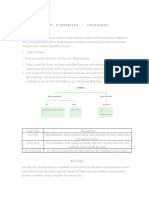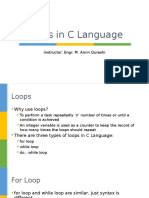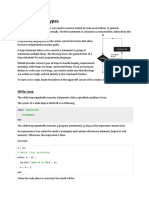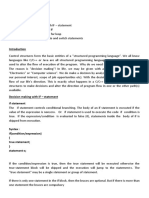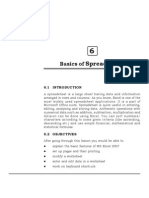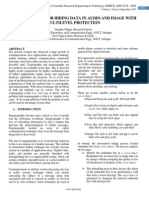14 Making Decisions in "C"
14 Making Decisions in "C"
Uploaded by
roselathikaCopyright:
Available Formats
14 Making Decisions in "C"
14 Making Decisions in "C"
Uploaded by
roselathikaOriginal Title
Copyright
Available Formats
Share this document
Did you find this document useful?
Is this content inappropriate?
Copyright:
Available Formats
14 Making Decisions in "C"
14 Making Decisions in "C"
Uploaded by
roselathikaCopyright:
Available Formats
14 MAKING DECISIONS IN C
14.1 INTRODUCTION So far we have seen that in C programs the instructions are executed in the same order in which they appear in the program. Each instruction is executed once and once only. Programs do not include any logical control structures. Most programs, however, require that a group of instructions be executed repeatedly, until some logical condition has been satisfied. This is known as looping. Most of the programs require that a logical test be carried out at some particular point within the program. An action will then be carried out whose exact nature depends upon the outcome of the logical test. This is known as conditional execution. 14.2 OBJECTIVES After going through this lesson you would be able to define 'while' statement, for statement and nested loops explain switch statement and goto statement define comma operator 14.3 WHILE STATEMENT The while statement is used to carry out looping operations. The general form of the statement is
Making Decisions in C :: 213
while (expression) statement The loop operates in the following fashion: The value of the test expression enclosed in parentheses is evaluated. If the result is true, then the program statement (the body of the loop) is executed. The statement may be a compound statement. Then the test expression, which may be just as complex as any of those found in if statement is evaluated again. If it is again true, the statement is executed once more. This process continues until the test expression becomes false. At that point, the loop is terminated immediately, and program execution continues with the statement (if any) following the while loop. If there are no more statements, the program terminates. Let us consider an example, which prints the five lines. Each line is numbered by printing out the value of x each time around the loop. / * A test program for while loop */ include<stdio.h> main() { int x=1; while(x<6) { print(This is line number %d of test program\n,x); x++; } } The variable x is assigned a value of 1. The while loop displays the line number of test program by incrementing the value of x by one each time until the value of x is less than 6. Thus the loop will be repeated 5 times, resulting in 5 consecutive lines of output. Thus, when the program is run, the following output will be generated. This is line number 1 of test program. This is line number 2 of test program. This is line number 3 of test program. This is line number 4 of test program. This is line number 5 of test program.
214 :: Computer Applications
This program can be written more concisely as #include <stdio.h> main() { int x=1; while (x<6) printf(This is line number %d of test program\n;x++); } When executed, this program will generate the same output as the first program. All variables used in the test expression of the while statement must be initialized at some point before the while loop is reached. In addition, the body of the loop must do something to change the value of the variable used in the expression being tested. Otherwise the condition would remain true and the loop would never terminate. This situation, known as an infinite loop, is illustrated next. while(x<6) printf(Something is wrong in this loop\n); The loop is infinite because the value of x is never change. If the test expression starts out being true, it remains true forever. In the previous program, the value of x determines how many times the loop executes. Therefore, the second statement in the body of the loop (x++;) serves to increment x by 1. Since x starts out with a value of 1 and is incremented by 1, at some point it must become equal to 6. Then the condition in the while loop becomes false and the loop is terminated. If x were initialized to a value of 6, the condition in the while loop becomes false to begin with , and the body of the loop would not be executed at all. It is clear, then, that the while statement employs a loop pre-test. The loop condition is tested before each iteration, and therefore before the loop is entered at all. If the condition initially fails, the loop is skipped entirely. If the test expression involves two variables and joined with and or OR operator #include <stdio.h>
Making Decisions in C :: 215
main() { int x=1; int a=4; while (x<6 && a>3) { printf( This is line number %d of test program \n,x); x++; } } The loop executes only while x is less than 6 and a is greater than 3. If at least one of these conditions becomes false, the loop terminates. If at least one of the conditions is false when the loop is first encountered, the loop is skipped entirely. The value of a is not changed in the loop, but the value of x is incremented in a way that will make the loop terminate eventually. If the value of a is less than or equal to 3, then the initial test fails and the while loop is skipped entirely. There is another way to use while loop, instead of incrementing the value of variables inside the loop, you can also decrement it. For example, if you want to print the line number of test program in reverse order then test expression changes and the program is as follows: #include <stdio.h> main() { int x = 0 printf(This is line number of test program in reverse order); while(x>=0) { printf(%d\n,x); x- -; } }
216 :: Computer Applications
There is an option for test expression in while loop, instead of giving some constant value to test variable you can even given it some variable also. The value of this variable can be input from the user interactively e.g. if the user wants to calculate the average of numbers, but how many numbers? this number can be input from the user itself and then this variable can be used in test expression. Let us consider an example. #include <stdio.h> main() { int number, n=1; float x, average, sum=/0; printf(How many number ?); scanf(%d, & number); while(n<=number) { scanf(%f, &x); sum=sum+x; ++n; } average=sum/number; printf(\n The average is %f \n, average ); } The output of this program is as follows: How may number? 6 1. 2. 3. 4. 5. 6. The average is 3.500000
Making Decisions in C :: 217
do......while loop The do while loop differs from its counter part, the while loop in that it makes what is called a loop post-test. That is the condition is not tested until the body of the loop has been executed once. In the while loop, by contrast, the test is made on entry to the loop rather than at the end. The effect is that even if the condition is false when the do-while loop is first encountered, the body of the loop is executed at least once. If the condition is false after the first iteration, the loop terminates. If the first iteration has made the condition true, however the loop continues. The general form of the do.while loop is as follows: do Statement; while (test expression); The fact that the while clause is located after the statement reflects the fact that the test is made after the statement is executed. If the body of the loop is a single statement, it must be terminated with a semicolon. For example: do a=a+10; while (a<b); This semicolon marks the end of the inner statement only not of the entire loop construct. In every situation that requires a loop, either one of these two loops can be used. Let us consider an example: #include <stdio.h> main() { int numbers, n=1; float x,average ,sum=0; printf(How many number ?); scanf(%d, &numbers); do { scanf(%f; &x); sum=sum+x;
218 :: Computer Applications
++n; } while (n<=numbers); average=sum/numbers; printf(\n The average is %f\n, average); } The output of this program is same as that with while loop. INTEXT QUESTIONS 1. 2. 3. 4. What happens if the condition in a while loop is initially false? What is the minimum number of times the body of a do while loop is executed? What is the essential difference between a while and a do. While loop? Define syntax for do. While loop?
14.4 FOR STATEMENT The for statement is the most commonly used looping statement in 'C'. This statement includes an expression that specifies an initial value for an index, another expression that determines whether or not the loop is continued and the third expression that allows the index to be modified at the end of each pass. The general form of the for statement is for (expression1; expression2; expression3) statement Expression1 is the initialization expression, usually an assignment, which is performed once before the loop actually begins execution. Expression 2 is the test expression, exactly like the one used in the while loop, which is evaluated before each iteration of the loop and which, determines whether the loop should continue or be terminated. Finally, expression 3 is the modifier statement, which changes the value of the variable used in the test. This expression is executed at the end of each iteration, after the body of the loop is executed. Statement is the body of the loop, which may as usual be compound. The three loops expressions are separated by two semicolons. No semicolon should be placed after expression 3.
Making Decisions in C :: 219
The first expression of the for loop can be omitted if the variable is initialized outside the loop. If one or more expressions are omitted from the for loop, the two semicolons still must appear, even if they are not preceded or followed by anything. Let us understand the concept of for loop with the help of an example: #include <stdio.h> main() { int x; for(x=1; x<=10; x ++) printf(This is line number %d of test program\n,x); } The output for this program is as follows: This is line number 1 of test program This is line number 2 of test program This is line number 3 of test program This is line number 4 of test program This is line number 5 of test program This is line number 6 of test program This is line number 7 of test program This is line number 8 of test program This is line number 9 of test program This is line number 10 of test program In order to print the tenth line, the test expression must use the <= relational operators. If < alone were used, the loop would print only nine lines. Let us consider one more program to print first five even numbers through use of for loop. #include <stdio.h> main() { int i; for(i=2; i<=10; i=i+2)
220 :: Computer Applications
printf(%d\n, i); } The output of this program is as follows: 2 4 6 8 10 In the for loop, if the second expression is omitted, however it will be assumed to have a permanent value of 1 (true) thus the loop will continue indefinitely unless it is terminated by some other means, such as a break or a return statement. INTEXT QUESTIONS 5. 6. 7. 8. Which is the better loop to use, the for loop or the while loop? What is a special advantage of the for loop? What separates the three expressions of a for statement? How does the for loop operate?
14.5 NESTED LOOPS Loops can be nested or embedded one within another. The inner and outer loops need not be generated by the same type of control structure. It is essential, however that one loop be completely embedded within the other there can be no overlap. Each loop must be controlled by a different index. Let us consider an example of nested for loops: #include <stdio.h> main() { int i,j,n,sum; for(i=1;i<=5; i++) { printf(\nEnter a positive number:); scanf(%d,&n);
Making Decisions in C :: 221
sum=0; for(j=i; j<n; j++) { sum=sum+j; printf(\n The sum of the integers from 1 to %d is:%d\n, n,sum); } } } The output is as follows: Enter a positive number: 5 The sum of the integers from 1 to 5 is: 15 Enter a positive number: 10 The sum of the integers from 1 to 10 is: 55 Enter a positive number: 15 The sum of the integers from 1 to 15 is: 120 Enter a positive number: 20 The sum of the integers from 1 to 20 is: 210 Enter a positive number: 5 The sum of the integers from 1 to 25 is: 325 In this program firstly, outer for loop will be executed, if the expression (test) is true, sum variable is initialized to zero every time and then inner loop will be executed. Inner loop will be executed till the test expression of inner loop satisfies. Then if the expression is false, the pointer again goes to outer loop and then it will reexecute. For nested loops any other loop structures could also have been selected. 14.6 IFELSE STATEMENT C allows decisions to be made by evaluating a given expression as true or false. Depending upon the result of the decision, program execution proceeds in one direction or another. This is carried out in C by if statement. The simplest form of the if statement is as follows:
222 :: Computer Applications
if (expression) Statement; if statement will execute if the given expression is true. If the user wants to add more than one statement then there must be pair of curly braces after if. if (expression) { statement; statement; } Let us consider an example of if statement. #include <stdio.h> main() { char grade; printf(Enter a character value for grade:); scanf(%c, & grade); if(grade = = A) printf(The grade is excellent \n); printf(Thanks for using this program\n); } The output is as follows: Enter a character value for grade: A The grade is excellent thanks for using this program If we re-run the program with different value for grade than the output is Enter a character value for grade: C Thanks for using this program In the second case, the value for grade is C other than A which is in test expression of if statement, thus the first printf statement will not execute. In the previous program only the general message is printed if the
Making Decisions in C :: 223
user selects a grade other than A. If the user wants to display other message when enter a grade other than A, you have to add the else clause of if statement. The general form of if..else is as follows. if (statement) Statement 1; else Statement 1; Both if and else clause are terminated by semicolons. Let us consider an example of ifelse statement. #include <stdio.h> main() { char grade; printf(Enter a character value for grade:); scanf(%c, &grade); if(grade= =A) printf(grade is excellent \n); else printf(grade is other than excellent\n"); } The user can use compound statements both in if and else statements. The first printf is executed if and only if grade is equal to A, if grade is not equal to A, the first printf is ignored, and the second printf, the one following the word else, is executed. A clause of the if statement may itself contain another if statement, this construct known as nesting of if statements. Let us consider an example nested if..else statement: #include <stdio.h> main() { int year; printf(Enter a year to check for leap year); scanf(%d, & year); if (year %4= = ),
224 :: Computer Applications
if(year %100 != 0) printf(%d is a leap year:\n, year); else if(year %400 = =) printf(%d is a leap year \n,year); else printf(%d is not a leap year \n, year); else printf (%d is not a leap year\n, year); } It is very important to be sure which else clause goes with which if clause. The rule is that each else matches the nearest if preceding it which has not already been matched by an else. Addition of braces prevents any association between the if statement within the braces and the else clause outside them. Even where braces are not necessary, they may still be used to promote clarity. INTEXT QUESTIONS 9. In an if statement, if two separate statements are to be executed when the comparison is true, what must be done with them?
10. What is the function of the else clause in an if statement? 14.7 SWITCH STATEMENT The switch statement causes a particular group of statements to be chosen from several available groups. The selection is based upon the current value of on expression that is included within the switch statement. The general form of the switch statement is switch (expression) statement Where expression results in an integer value. Expression may also be of type char, since individual characters have equivalent integer values. The embedded statement is generally a compound statement that specifies alternate courses of action. Each alternative is expressed as a group of one or more individual statements within the overall embedded statement. For each alternative, the first statement within the group must be preceded by one or more case labels. The case labels identify the different groups of statements and
Making Decisions in C :: 225
distinguish them from one another. The case labels must therefore be unique within a given switch statement. Thus, the switch statement is in effect an extension of the familiar ifelse statement. Rather than permitting maximum of only two branches, the switch statement permits virtually any number of branches. In general terms, each group of statements is written as case expression1; case expression2; : : case expression m: Statement 1 Statement 2 : Statement n Where expression 1, expression 2. Expression n represent constant, integer valued expressions. Each individual statement following the case labels may be either simple or complex. When the switch statement is executed, the expression is evaluated and control is transferred directly to the group of statements whose case-label value matches the value of the expression. If none of the case-label value matches the value of the expression, then none of the groups within the switch statement will be selected. In this case control is transferred directly to the statement that follows the switch statement. Let us consider an example of switch statement: #include <stdio.h> main() { char vowel; printf(Enter a character); scanf(%c,&vowel); switch(vowel) { casea
226 :: Computer Applications
caseA: printf(vowel); break; case e : case E: printf(vowel); break; case i : case I : printf(vowel); break; case o : case O : printf(vowel); break; case u : case U : printf(vowel); } } One of the labeled groups of statements within the switch statement may be labeled default. This group will be selected if none of the case labels matches the value of the expression. The default group may appear anywhere within the switch statement. If none of the case labels matches the value of the expression and default group is not present, then the switch statement will take no action. #include <stdio.h> main() { char vowel; printf(Enter a character); scanf(%c, & vowel); switch(vowel) { case a: case A: printf(vowel);
Making Decisions in C :: 227
break; casee: case E: printf(vowel); break; case i : case I: printf(vowel); break caseo: case O: printf(vowel); break; caseu u: printf(vowel); break; default: printf(Not a vowel); } } The default label can be placed anywhere within the body of the switch statement; it need not be the last label. In fact, the labels of a switch statement can appear in any order, depending on the logic of the program. It is desirable for several different values of the switch variable to cause execution of the same set of statements. This can be accomplished by including several labels in succession with no intervening statements. 14.8 THE BREAK STATEMENT The break statement is used to force fully terminate loops or to exit from a switch. It can be used within a while, a do-while, for or a switch statement. The format is simple as break; without any embedded expression or statements. The break statement causes a transfer of control out of the entire switch statement, to the first statement following the switch statement.
228 :: Computer Applications
If a break statement is included in a while, in do while or in for loop, then control will immediately be transferred out of the loop when the break statement is encountered. Thus provides a convenient way to terminate the loop if an error or other irregular condition is detected. Let us consider a program segment of break statement in while loop. #include <stdio.h> main() { int x, sum=; printf(Enter any number); scanf(%d &x); while(x<=50) { if (x<zero) { printf(error value because of negative value); break; } scanf(%d, &x); } The continue statement is used to bypass the remainder of the current pass through a loop. The loop does not terminate when a continue statement is encountered, instead the remaining loop statements are skipped and the computation proceeds directly to the next pass through the loop. It can also be included within a while, do while or a for statement as like break statement. It is also written simply as continue; without any embedded statement or expression. 14.9 THE COMMA OPERATOR Comma operator is used primarily in conjunction with the for statement. This operator permits two different expressions to appear in situation where only one expression would ordinarily be used.
Making Decisions in C :: 229
For example: for (expression 1a, expression 1b; expression 2; expression 3) statement. where expression 1a and expression 1b are the two expressions, separated by comma operator, where only one expression would normally appear. Let us consider an example: #include<stdio.h> main() { int i,j,n; printf(Enter number for a table); scanf(%d, &n); printf(\n); for(i=0, j=n; i<n; i++, j ) printf(%3d+%3d= %3d\n, i,j,n); } The output is as follows: Enter number for a table 20 0+20=20 1+19=20 2+18=20 3+17=20 4+16=20 5+15=20 6+14=20 7+13=20 8+12=20 7+13=20 8+12=20 9+11=20
230 :: Computer Applications
10+10=20 11+9=20 12+8=20 13+7=20 14+6=20 15+5=20 16+4=20 17+3=20 18+2=20 19+1=20 20+0=20 The comma operator has the lowest precedence. Thus, the comma operator falls within its own unique precedence group, beneath the precedence group containing the various assignment operators. Its associatively is left-to-right 14.10 THE GOTO STATEMENT The goto statement is used to alter the normal sequence of program execution by transferring control to some other part of the program. It is written as goto label; Where label is an identifier used to label the target statement to which control will be transferred. Control may be transferred to any other statement within the program. The target statement must be labeled, and the label must be followed by a colon. Thus the target statement will appear as Label : statement No two statements cannot have the same label Goto statements has many advantages like branching around statements or groups of statements under certain conditions, jumping to the end of a loop under certain conditions, thus bypassing the remainder of the loop during the current pass, jumping completely out of a loop under certain conditions, thus terminating the execution of a loop.
Making Decisions in C :: 231
14.11 WHAT YOU HAVE LEARNT In this lesson, you have learnt about different types of loops like for, do..while, while. You are now familiar with if-else statement and switch statement. You are now also familiar with comma operators, break and continue statement and goto statement. You can very well use all of them in a C program to make a program interactive and user friendly. 14.12 TERMINAL QUESTIONS 1. 2. 3. 4. 5. 6. 7. 8. What is meant by looping? Describe two different forms of looping. What is the purpose of while statement? How is the execution of a while loop terminated? How many times will a for loop be executed, what is the purpose of the index in a for statement? What is the purpose of the switch statement? Compare the use of the switch statement with the use of nested if else statement? What is the use of break and continue? What is the purpose of goto statement. Explain their usage in the program.
14.13 KEY TO INTEXT QUESTIONS 1. 2. 3. The while loop is skipped over One A while loop performs its test before the body of the loop is executed, whereas a do..loop makes the test after the body is executed. do Statement; while (test expression); 5. It depends on the nature of the problem to be solved, and upon the preference of the programmer
4.
232 :: Computer Applications
6. 7. 8.
The initialization, testing and modifier expressions of the loop all are specified within a single set of parentheses. Semicolons The first expression is executed once. Then the second expression is tested, if it is true, the body of the loop is executed. Then the third expression is executed. Again, second expression is evaluated, till the second expression is true, the body of the loop is executed, followed by the third expression. They must be combined into a compound statement, using the curly braces { and }.
9.
10. If present, it is followed by a statement that is executed only if the condition being tested proves to be false.
You might also like
- Protocompiler Reference PDFDocument166 pagesProtocompiler Reference PDFajaysimhaNo ratings yet
- PA - Ba - Elevator Test 90min - Aditya DashDocument4 pagesPA - Ba - Elevator Test 90min - Aditya DashAditya Kumar Dash100% (1)
- Unit 3.1Document44 pagesUnit 3.1BhagavanNo ratings yet
- Construct 3 - Repetition / Looping by Prof. Elijah Omwenga October 2012Document25 pagesConstruct 3 - Repetition / Looping by Prof. Elijah Omwenga October 2012millerNo ratings yet
- Ip Iy Iis Unit 2Document13 pagesIp Iy Iis Unit 2Srinivas Kumar PalvadiNo ratings yet
- Labsheet 5Document15 pagesLabsheet 5saurabharpitNo ratings yet
- LoopingDocument30 pagesLoopingsakshamsingh13617No ratings yet
- C Programming - Decision Making - LoopingDocument7 pagesC Programming - Decision Making - Loopingneo_411No ratings yet
- Unit IiiDocument14 pagesUnit Iiigouravsingh633518No ratings yet
- Cse 122Document3 pagesCse 122Shamima HossainNo ratings yet
- CSE Chapter 7 LoopsDocument15 pagesCSE Chapter 7 Loopsmagnaff2No ratings yet
- Introduction To Looping Control Structures - 1Document5 pagesIntroduction To Looping Control Structures - 1Edwin OdhiamboNo ratings yet
- The Decision Control StructureDocument42 pagesThe Decision Control StructureAmir AmirthalingamNo ratings yet
- Unit -2 _C ProgrammingDocument28 pagesUnit -2 _C Programmingvenkatesanmohan0No ratings yet
- Structured Programming Language: The LoopDocument53 pagesStructured Programming Language: The LoopShahed HossainNo ratings yet
- Loops in C LanguageDocument13 pagesLoops in C Languagemuhammad_ameenNo ratings yet
- Unit 3 CppsDocument13 pagesUnit 3 Cppsprithviraj gavhaneNo ratings yet
- Unit-2 Loops in C ProgrammingDocument21 pagesUnit-2 Loops in C ProgrammingrohanbinorkarNo ratings yet
- NotesDocument36 pagesNotesakashtj.yNo ratings yet
- L7 RevisedDocument14 pagesL7 RevisedkeexuepinNo ratings yet
- Python-Module 2 NotesDocument29 pagesPython-Module 2 Notessushmitha patil100% (1)
- While Loop 2. For Loop 3. Do While Loop: Practice The Following Concepts in This LabDocument8 pagesWhile Loop 2. For Loop 3. Do While Loop: Practice The Following Concepts in This LabM UmAr ArshAdNo ratings yet
- PPS UNIT II Control StatementsDocument33 pagesPPS UNIT II Control StatementsVarshith ReddyNo ratings yet
- Python Notes (Unit 2)Document23 pagesPython Notes (Unit 2)devgreat555No ratings yet
- QA Unit2Document16 pagesQA Unit2alysonmicheaalaNo ratings yet
- Chap 3 LOOPS IN CDocument10 pagesChap 3 LOOPS IN Ctokewe2388No ratings yet
- Looping Case StudyDocument9 pagesLooping Case StudyMukesh Kumar SinghNo ratings yet
- C Programming Looping StatementsDocument11 pagesC Programming Looping StatementsKartik RaghuwanshiNo ratings yet
- Unit 2 Introduction ProgrammingDocument11 pagesUnit 2 Introduction ProgrammingshabanasarwaniNo ratings yet
- Chapter EightDocument12 pagesChapter Eightn64157257No ratings yet
- Nested Conditional and Iterative StatementsDocument11 pagesNested Conditional and Iterative StatementsHarriette MojicaNo ratings yet
- C (CHAP-6 Looping Statements)Document25 pagesC (CHAP-6 Looping Statements)SS GAMERNo ratings yet
- Lecture 3: Introduction of Electrical PrincipleDocument9 pagesLecture 3: Introduction of Electrical PrinciplemoradNo ratings yet
- Chapter 7 Control StructuresDocument16 pagesChapter 7 Control Structuressyxdmatheen.9No ratings yet
- Chapter 5 - Control StatementDocument50 pagesChapter 5 - Control StatementRozlina MohamedNo ratings yet
- Python M2 PDFDocument25 pagesPython M2 PDFKishan Razer CruiseNo ratings yet
- Control Statement in JavaDocument4 pagesControl Statement in Javaarunverma47No ratings yet
- Module2 Python 15CS664Document18 pagesModule2 Python 15CS664study material100% (1)
- Lab 4 RepetitionDocument5 pagesLab 4 RepetitionjscansinoNo ratings yet
- Python Unit 2 2020Document16 pagesPython Unit 2 2020devNo ratings yet
- I QC ProgrammingDocument10 pagesI QC ProgrammingrosctNo ratings yet
- CP Chapter 2Document30 pagesCP Chapter 2Birju PrajapatiNo ratings yet
- LM - Unit4 2Document8 pagesLM - Unit4 2raisinghdaksh2No ratings yet
- Python Unit 2Document11 pagesPython Unit 2kgf0237No ratings yet
- 18CS752 - Python 3Document18 pages18CS752 - Python 3Adarsh ReddyNo ratings yet
- Control StatementsDocument17 pagesControl Statementsyatendra kashyapNo ratings yet
- Operator Precedence Operators Precedence: Expr++ ExprDocument9 pagesOperator Precedence Operators Precedence: Expr++ ExprShubhamNo ratings yet
- LoopsDocument4 pagesLoopsNOOR AHMEDNo ratings yet
- Soham Alu Loop Structure ProgrammingDocument18 pagesSoham Alu Loop Structure Programmingsohamalu5172No ratings yet
- C-Unit 3Document16 pagesC-Unit 3Sankaraiah MudiNo ratings yet
- Module - 2: IterationDocument18 pagesModule - 2: IterationDhanush H LNo ratings yet
- Unit-2 PSWCDocument14 pagesUnit-2 PSWCappikondaroopavardhan135No ratings yet
- 2.1 Iteration: Iteration, Loop Patterns, Strings, FilesDocument25 pages2.1 Iteration: Iteration, Loop Patterns, Strings, FilesVijay PawarNo ratings yet
- Matlab ManualDocument7 pagesMatlab ManualMoosa NaseerNo ratings yet
- Concept of Loops in JavaDocument7 pagesConcept of Loops in JavaPallvi SharmaNo ratings yet
- Example Program Based On Java Loop StatementDocument14 pagesExample Program Based On Java Loop StatementAmol AdhangaleNo ratings yet
- C - Loops: C Programming Language Provides The Following Types of Loops To Handle Looping RequirementsDocument20 pagesC - Loops: C Programming Language Provides The Following Types of Loops To Handle Looping RequirementskjhofboaNo ratings yet
- Module IiDocument23 pagesModule IiSmitha RajeshNo ratings yet
- UNIT - 3 Control StructureDocument15 pagesUNIT - 3 Control StructureRAVAN RATHORENo ratings yet
- C LoopsDocument10 pagesC LoopsAIM TechnologiesNo ratings yet
- BE EXPERT IN JAVA Part- 2: Learn Java programming and become expertFrom EverandBE EXPERT IN JAVA Part- 2: Learn Java programming and become expertNo ratings yet
- Lesson 6: Consumer Oriented E Commerce: Topic: Traditional RetailingDocument6 pagesLesson 6: Consumer Oriented E Commerce: Topic: Traditional RetailingroselathikaNo ratings yet
- Lesson 5: Web Based E Commerce Architecture: Topic: Uniform Resource LocatorDocument8 pagesLesson 5: Web Based E Commerce Architecture: Topic: Uniform Resource LocatorroselathikaNo ratings yet
- Lesson 2: Benefits and Limitations of E-CommerceDocument3 pagesLesson 2: Benefits and Limitations of E-CommerceroselathikaNo ratings yet
- 16 Arrays: L L L LDocument17 pages16 Arrays: L L L LroselathikaNo ratings yet
- Lesson 3: Generic Framework of E-Commerce: TopicsDocument4 pagesLesson 3: Generic Framework of E-Commerce: TopicsroselathikaNo ratings yet
- 13 A Complete C ProgramDocument8 pages13 A Complete C ProgramroselathikaNo ratings yet
- 21 Setting Up A Computer Business Centre: L L L L LDocument7 pages21 Setting Up A Computer Business Centre: L L L L LroselathikaNo ratings yet
- 9 Creating Reports With Report Wizard and Report DesignerDocument21 pages9 Creating Reports With Report Wizard and Report DesignerroselathikaNo ratings yet
- Lesson 6Document34 pagesLesson 6roselathikaNo ratings yet
- Input OutputDocument13 pagesInput OutputAman GulatiNo ratings yet
- 7 Creating Query With Query Wizard and Query Designer: L L L LDocument27 pages7 Creating Query With Query Wizard and Query Designer: L L L LroselathikaNo ratings yet
- 15 PointerDocument8 pages15 PointerroselathikaNo ratings yet
- Formatting Documents:: 59Document29 pagesFormatting Documents:: 59roselathikaNo ratings yet
- Computer ScienceDocument97 pagesComputer Scienceroselathika100% (2)
- 12 Structure, Typedef & Enumerated Data Type: L L L LDocument12 pages12 Structure, Typedef & Enumerated Data Type: L L L LroselathikaNo ratings yet
- 14 Inheritance Extending Classes: L L L L LDocument15 pages14 Inheritance Extending Classes: L L L L LroselathikaNo ratings yet
- 11 Array: L L L L LDocument14 pages11 Array: L L L L LroselathikaNo ratings yet
- 9 Control Statements: L L L L L LDocument30 pages9 Control Statements: L L L L L LroselathikaNo ratings yet
- Artificial IntelligenceDocument107 pagesArtificial IntelligenceDebasish NayakNo ratings yet
- New Technique For Hiding Data in Audio and Image With Multilevel ProtectionDocument4 pagesNew Technique For Hiding Data in Audio and Image With Multilevel ProtectionijsretNo ratings yet
- Web 06CSL78 Lab ManualDocument36 pagesWeb 06CSL78 Lab ManualAnonymous 5xXWXiIi1No ratings yet
- Control and InstrumentationDocument31 pagesControl and InstrumentationSiva MurugesanNo ratings yet
- A429 Users ManualDocument244 pagesA429 Users ManualbaburaokodavatiNo ratings yet
- Attachment1. Journey To The Cloud 2019Document21 pagesAttachment1. Journey To The Cloud 2019kshitij bhardwajNo ratings yet
- AAOD DeveloperGuide PDFDocument658 pagesAAOD DeveloperGuide PDFVictor Hugo SantosNo ratings yet
- 3BSE091397 en E ABB Ability System 800xa 6.1 Product Catalog PDFDocument118 pages3BSE091397 en E ABB Ability System 800xa 6.1 Product Catalog PDFsiva kumarNo ratings yet
- HDLCDocument34 pagesHDLCChin Bim100% (1)
- 8 2 Agile & Stage Gate Debunking The MythsDocument5 pages8 2 Agile & Stage Gate Debunking The MythsIvaNo ratings yet
- Embedded SystemDocument300 pagesEmbedded Systemsumathi100% (2)
- Doulus SystemC TutorialDocument23 pagesDoulus SystemC TutorialFrankie LiuNo ratings yet
- Windows Server 2012 Server RolesDocument4 pagesWindows Server 2012 Server RolesAndrei BurlacuNo ratings yet
- 16 Mark Questions: Structure of Relational DatabasesDocument48 pages16 Mark Questions: Structure of Relational DatabasesslogeshwariNo ratings yet
- Firewall AssignmentDocument5 pagesFirewall Assignmentanon_555513071No ratings yet
- Android Bluetooth TutorialDocument8 pagesAndroid Bluetooth Tutorialpakadam7No ratings yet
- OFX Implementation Guide For OFX 2.2 and OAuthDocument29 pagesOFX Implementation Guide For OFX 2.2 and OAuthffapmadNo ratings yet
- Complete MIS Notes - VTH SemDocument9 pagesComplete MIS Notes - VTH Semhoneydesires100% (4)
- GPIO (Interrupt Mode) : Lea Dominique FariolaDocument4 pagesGPIO (Interrupt Mode) : Lea Dominique FariolaLea Dominique Mangubat FariolaNo ratings yet
- PortDocument4 pagesPortDinko DiĐNo ratings yet
- Embedded C Interview QuestionsDocument3 pagesEmbedded C Interview Questionsmelvin4575% (4)
- Pipelining DLX PDFDocument64 pagesPipelining DLX PDFKunal SinghNo ratings yet
- Operating Systems Lab Manual JNTUDocument9 pagesOperating Systems Lab Manual JNTUmannanabdulsattar100% (1)
- TN482Document9 pagesTN482syed muffassirNo ratings yet
- Image ProcessingDocument38 pagesImage ProcessingJoy Thakur79% (14)
- A Strategic Approach To Teaching Programming at KS3Document23 pagesA Strategic Approach To Teaching Programming at KS3radebpNo ratings yet
- Creating Simple ASP Pages: Adding Server-Side Script CommandsDocument11 pagesCreating Simple ASP Pages: Adding Server-Side Script CommandsPassmore DubeNo ratings yet
- Lab2 Wireshark TCP Ch3 SolDocument14 pagesLab2 Wireshark TCP Ch3 SolKuro ShiroNo ratings yet










